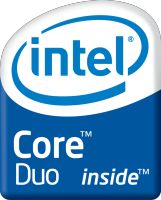Intel’s convention of naming its processor series is quite interesting. The first processor of the x86 series was the 8086 processor, then 80186 and then shortened to 286, 386, 486. After 486, Intel rather changed the series name to PENTIUM instead of 586. The march kept continuing with Pentium series like Pentium , Pentium 2 , Intel Pentium 3 and up to Pentium 4. The differences were quite clear. Then Intel introduced The Pentium D is simply two Pentium 4 Prescott cpus inefficiently paired together and ran as dual core.

The Core Duo (generic name for this type is Dual Core) is Intel’s first generation dual core processor based upon the Pentium M (a Pentium III-4 hybrid) made mostly for laptops (though a few motherboard manufacturers have released desktop boards supporting the Core Duo CPU), and is much more efficiently than Pentium D.

The Core 2 Duo is Intel’s second generation processor made for desktops and laptops designed from the ground up to be fast while not consuming nearly as much power as previous CPUs.
There is another great difference between Core Duo and Core 2 Duo. Core Duo operates in 32 – bit where as Core 2 Duo is a 64 – bit Processor.
According to an Intel expert the difference is as follows :
A dual core processor is a CPU with two separate cores on the same die, each with its own cache. It’s the equivalent of getting two microprocessors in one.
Dual core technology refers to two individual microprocessors on a single die cast chip. This is essentially two computer processing units (CPUs) in one. The advantage of a dual core chip is that tasks can be carried out in parallel streams, decreasing processing time. This is referred to as thread-level parallelism (TLP).
TLP is also possible on motherboards that can accommodate two separate CPU dies. When TLP is accomplished in a single CPU through dual core technology, it is called chip-level multiprocessing (CLM).
In dual core CPUs, each microprocessor generally has its own on-board cache, known as Level 1 (L1) cache. L1 cache significantly improves system performance, because it is much faster to access on-chip cache than to use random access memory (RAM). L1 cache is accessed at microprocessor speeds.
The Intel® Core™2 Duo desktop processor delivers revolutionary dual-core performance and breakthrough processor energy efficiency.
Based on the revolutionary Intel® Core™ Microarchitecture, the Intel Core 2 Duo processor has been developed for an increasingly multimedia-centered, high-definition world, and is designed to do more in less time.
Intel Core 2 Duo processors operate at lower frequencies while producing higher performance compared to today’s higher frequency processors, thus enabling quieter and smaller desktop PCs.
Therefore we can conclude like this:
Core Duo vs Core 2 Duo
2 Core in a Single chip 2 Core in a single Chip
32 – bit 64 – bit
Consume more power Comparatively less
2 MB L2 Cache 4 MB L2 Cache
First Generation 2nd Generation
I am sure there are more differences, and if you know any of them I request you to share it with us.

THANKS ALOT